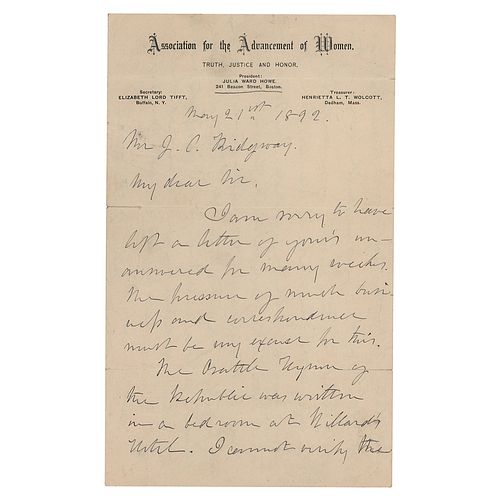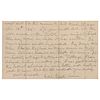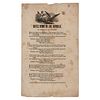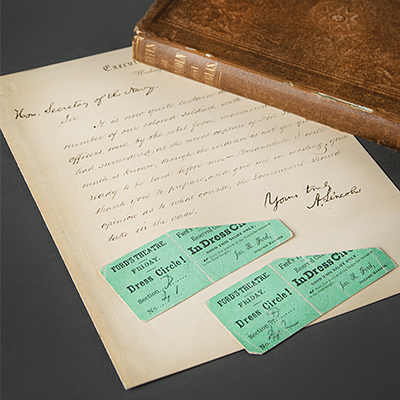Julia Ward Howe ALS on The Battle Hymn of the Republic, "written in a bedroom at Willard’s Hotel"
Two ways to bid:
- Leave a max absentee bid and the platform will bid on your behalf up to your maximum bid during the live auction.
- Bid live during the auction and your bids will be submitted real-time to the auctioneer.
Bid Increments
| Price | Bid Increment |
|---|---|
| $0 | $5 |
| $50 | $10 |
| $200 | $25 |
| $500 | $50 |
About Auction
Sep 23, 2023
RR Auction support@rrauction.com
- Lot Description
ALS, one page both sides, 5.5 x 9, Association for the Advancement of Women letterhead, May 21, 1892. Handwritten letter to J. C. Ridgway, in part: “I am sorry to have left a letter of yours unanswered for many weeks. The pressure of much business and correspondence must be my excuse for this. The Battle Hymn of the Republic was written in a bedroom at Willard’s Hotel. I cannot verify the exact date at this moment, but think it was Nov. 18th, 1861. If you could look at the old record of the Hotel, you might find the very room in which it was written. Dr. Howe’s name would be recorded‰Û_I think they had put me down as Miss Howe. This was because we had two rooms.” In fine condition. Accompanied by a printed copy of The Battle Hymn of the Republic, published by the Supervisory Committee for Recruiting Colored Regiments.
In November 1861, Governor John A. Andrew of Massachusetts entertained a party from his state on a 12-day visit to Washington D.C. The party included Dr. Samuel Gridley Howe, employed with the relief work of the Sanitary Commission (a precursor of the Red Cross), his wife Julia Ward Howe, a poet and ardent Abolitionist, and the Reverend James Freeman Clarke. While there, Howe watched a public review of Union troops as they belted out a well-known marching song called ‘John Brown’s Body,’ after the famous abolitionist, John Brown. It was there and then that Clarke encouraged Howe to write new lyrics to the tune. A fervent Union supporter and abolitionist herself, Howe traveled back to her hotel room at the Willard in Washington and woke with lyrics in her head.
‘I went to bed and slept as usual‰Û_But awoke the next morning in the gray of the early dawn, and to my astonishment found that the wished-for lines were arranging themselves in my brain. I lay quite still until the last verse had completed itself in my thoughts, then hastily arose, saying to myself, I shall lose this if I don’t write it down immediately. I searched for an old sheet of paper and an old stub of a pen which I had had the night before, and began to scrawl the lines almost without looking, as I learned to do by often scratching down verses in the darkened room when my little children were sleeping. Having completed this, I lay down again and fell asleep, but not before feeling that something of importance had happened to me.’
Shortly thereafter she sent the poem to the Atlantic Monthly, which paid her $4 for it and gave it the name the ‘Battle Hymn of the Republic,’ publishing it on its front page in February of 1862. It became one of the most popular songs of the Civil War era and has since become an enduring patriotic tune for over 160 years. - Shipping Info
-
Bidder is liable for shipping and handling and providing accurate information as to shipping or delivery locations and arranging for such. RR Auction is unable to combine purchases from other auctions or affiliates into one package for shipping purposes. Lots won will be shipped in a commercially reasonable time after payment in good funds for the merchandise and the shipping fees are received or credit extended, except when third-party shipment occurs. Bidder agrees that service and handling charges related to shipping items which are not pre-paid may be charged to a credit card on file with RR Auction. Successful international Bidders shall provide written shipping instructions, including specified Customs declarations, to RR Auction for any lots to be delivered outside of the United States. NOTE: Declaration value shall be the item’(s) hammer price and RR Auction shall use the correct harmonized code for the lot. Domestic Bidders on lots designated for third-party shipment must designate the common carrier, accept risk of loss, and prepay shipping costs.
-
- Buyer's Premium



 EUR
EUR CAD
CAD AUD
AUD GBP
GBP MXN
MXN HKD
HKD CNY
CNY MYR
MYR SEK
SEK SGD
SGD CHF
CHF THB
THB













